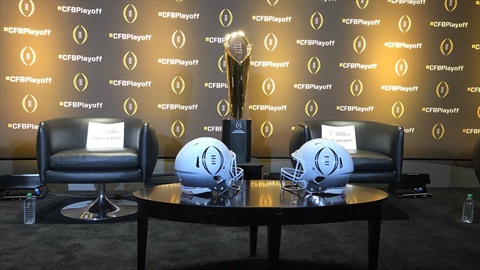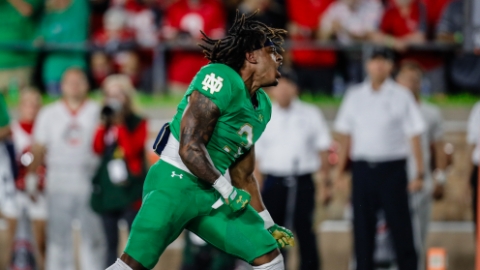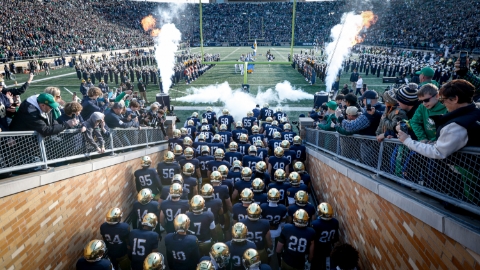
Great defense and Notre Dame are becoming synonymous.
Notre Dame isn’t winning 33 games in the last three seasons without it and they’ll continue to win at this clip (or better) as long as the defense continues to play at this level (or better).
It’s impossible to play that level of defense without a very good defensive line. That’s what Notre Dame had in 2012 when they had their best defense in the past decade. That’s what they’ve had the last three years as well.
The defensive line hasn’t always been a strength, though. In between 2012 and 2017, the group suffered from a lack of depth. It’s not entirely surprising that it went from the top-five in FEI’s defensive ratings to 45th, 65th, 58th, and 54th during that time period.
It’s been a journey where the group has evolved in a lot of ways under Mike Elston and he has evolved as well. Once seen as a square peg in a round hole when the defense switched from a 30 (three down linemen) to a 40 front (four down linemen), he has taken a big step as a coach and an even bigger step as a recruiter.
Here’s a look at how Notre Dame went from average up front to having a deep and talented group that is poised to continue the recent tradition of great defense.
Recruiting misses piled up
This was the season where Notre Dame made the switch to a 4-3 defense under Brian VanGorder. No one would dare claim that BVG did a good job while coaching for the Irish, but no one could say he didn’t inherit some personnel problems when he took over.
The Irish signed what at the time appeared to be a loaded class on the defensive line in 2011. Three years later and zero of those six D-linemen they signed were on the team in 2014 when they should have been entering their fourth year.
Stephon Tuitt left early for the NFL, but the rest were not there for other reasons. Aaron Lynch (transfer), Ishaq Williams (academics), Troy Niklas (position switch and left early for the NFL), Tony Springmann (medical), and Brad Carrico (position switch then medical) were all no longer with the program.
The staff only took three D-linemen in the following class, but followed that up with two in 2013 despite already knowing that Lynch, Niklas, and Carrico weren’t going to be in the defensive line room at the time they were recruiting for the ‘13 cycle. One of those two D-linemen in ‘13 was Jacob Matuska, a prospect many schools preferred at tight end.
This meant that Notre Dame had three juniors from the ‘12 cycle (Sheldon Day, Jarron Jones, and Romeo Okwara) with a sophomore from the ‘13 cycle (Isaac Rochell) as the starters and the rest of the rotation was going to have to consist of freshmen.
That would be a problem for any program and was a much bigger issue for Notre Dame where they reached for players out of need in the ‘14 cycle (Kolin Hill, Jhonny Williams, and Pete Mokwuah) and only recruited one player who would develop into a multi-year starter out of the other five defensive linemen they took (Jonathan Bonner).
While Andrew Trumbetti, Jay Hayes, and Daniel Cage played a good amount of snaps in their career, it was more out of necessity than talent. It’s debatable that any of them would have projected to be in the rotation for Notre Dame in 2019.
Going into the next class, the staff took four defensive tackles in the ‘15 cycle and the one who became a great player, Jerry Tillery, was originally considered to be an offensive lineman. The other three players failed to crack the rotation during their time at Notre Dame.
It all led to Notre Dame being crippled by their depth with one significant injury in 2014 and that they couldn’t rely on anything outside of the starters again in 2015. By the time the three players from the ‘12 cycle were gone, the 2016 defensive line was set up to be the worst one for the Irish in a long time.
Keith Gilmore, the defensive line coach in 2015 and 2016, didn’t exactly have the best luck being handed that group in his last year with the Irish. That line finished a dismal 115th in sack rate and 120th in passing down sack rate.
The turn around
While Gilmore was replaced by Elston, who switched back to the defensive line in 2017 after coaching the linebackers the previous two years, Gilmore did leave Elston a gift with the defensive ends he recruited in the 2016 cycle.
Khalid Kareem, Julian Okwara, Daelin Hayes, and Ade Ogundeji are in the running for the best defensive end class Notre Dame has ever signed. Gilmore gets extra credit for Ogundeji after evaluating him at a camp and then offering when he was seen as a low Power 5 prospect at the time. They became foundational players on the defensive line with Hayes and Ogundeji still on the roster today.
Hayes was a starter on the ‘17 team and Kareem and Okwara cracked the rotation. Even while playing a combined 275 less snaps than Jay Hayes and Trumbetti, Kareem and Okwara combined for 14 Havoc plays to 10.5 for Hayes and Trumbetti.
That defensive line only rotated three on the interior along with five ends with Elston getting them to play very well. They improved 49 spots in sack rate. That number improved nine more spots in ‘18 and were all the way up to 13th last season.
The pass rush was unrecognizable when compared with that 2016 defensive line.
Elston deserves a ton of credit for the way he has developed the line the last few years. The improvements we’ve seen from Tillery, Kareem, Okwara, Ogundeji, Daelin Hayes, and Jamir Jones under his watch have been significant. He’s also recruited and evaluated at a much higher level since moving back to working with the line.
It starts with Myron Tagovailoa-Amosa at the end of the ‘17 cycle and continues on with being able to keep Jayson and Justin Ademilola in the fold in ‘18. Jacob Lacey (2019) already looks like a future star inside for the Irish and there are high hopes for Isaiah Foskey and Howard Cross as well (all 2019).
Notre Dame has not landed a player on the defensive line in the last three cycles that doesn’t have the potential to be a starter or a quality rotation player. That’s why they can lose Okwara, Kareem, and Jones and not be worried about a massive drop off in production and why the future looks just as bright as what we saw last fall.
A change in emphasis
The improvement on the defensive line has a lot to do with the development and evaluation, but it also has to do with the change at coordinator. It’s not so much about scheme as it is an emphasis on specific things that have made the defensive line more productive.
VanGorder was all about scheme and at times seemed like he couldn’t see the forest for the trees. Mike Elko and Clark Lea emphasized fundamental development as well as playing sound within the scheme. It’s shown on the field at all three levels.
Elston’s group has caused a lot more Havoc because it’s been a priority to do so under Elko and Lea. The defensive line caused 64.5 Havoc plays in 2018. They caused 64 Havoc plays this past season. A huge part of that Havoc was forced fumbles.
The defensive line combined for 17 of them the last two seasons. They only had 12 from 2013-2016.
The 2020 defensive line has the potential to be three deep at every spot. Much like 2019, they might have more players capable of playing in sub-packages to rush the passer than they have snaps to give out. This is the new standard for defensive line at Notre Dame and it’s how it should be every season.
Another great defensive line means they’re all set to have another great defense this season. It’s a nice problem to have when you consider that it wasn’t that long ago they lacked the talent and depth to give the defense any chance to be great.



